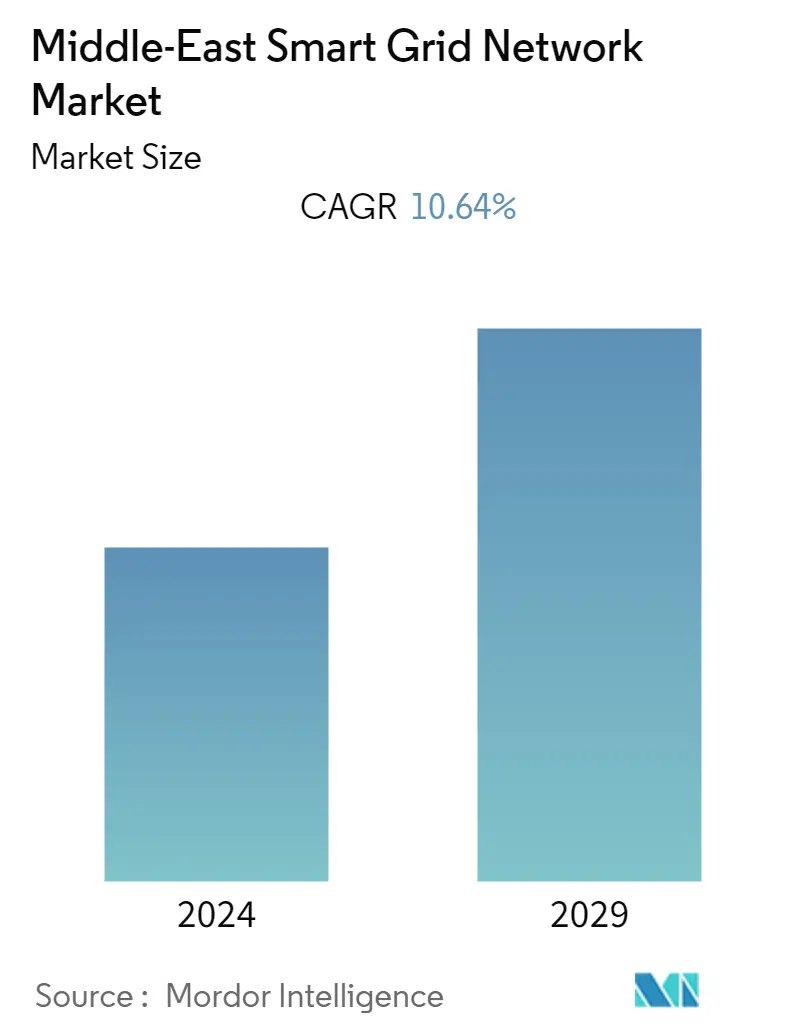Market Size of Middle-East Smart Grid Network Industry

| Study Period | 2020 - 2029 |
| Base Year For Estimation | 2023 |
| Forecast Data Period | 2024 - 2029 |
| Historical Data Period | 2020 - 2022 |
| CAGR | 10.64 % |
| Market Concentration | Medium |
Major Players
*Disclaimer: Major Players sorted in no particular order |
Middle-East Smart Grid Network Market Analysis
The Middle-East smart grid network market is expected to register a CAGR of 10.64% during the forecast period.
The market was negatively impacted by COVID-19 in 2020. Presently the market has now reached pre-pandemic levels.
- Over the long term, factors such as increasing renewable energy deployment and increasing installations of smart grid meters are expected to drive the market.
- On the other hand, Cyber security is a major concern in the smart grid network market and is expected to act as a restraint in the coming years as more and more data comes online.
- Nevertheless, the increasing investments in the EV charging infrastructure to reduce carbon emissions from the transportation sector and support the increasing adaption of EVs are likely to act as an opportunity for the smart grid market in the Middle East region during the forecast period.
- Saudi Arabia is expected to dominate the growth of smart grids in the Middle-East region during the forecast period.
Middle-East Smart Grid Network Industry Segmentation
A smart grid is an electrical network that uses digital and other advanced technologies to monitor and manage the transportation and distribution of electricity from all generation sources to meet the varying electricity demands of end users. The Middle-East smart grid network market is segmented by component, application, and by geography. By component type, the market is segmented by hardware and software. By application, the market is segmented by power generation and transmission networks, distribution and advanced metering infrastructure (AMI). By geography, the market is segmented by region. For each segment, the market sizing and forecasts have been done based on revenue (USD Billion).
| Component | |
| Software | |
| Hardware (including Sensors, Communication Equipment, and others) |
| Application | |
| Power Generation and Transmission Networks | |
| Distribution and Advanced Metering Infrastructure (AMI) | |
| Other Technology Application Areas (EVs, Energy Storage, etc.) |
| Geography | |
| United Arab Emirates | |
| Saudi Arabia | |
| Kuwait | |
| Qatar | |
| Rest of the Middle East |
Middle-East Smart Grid Network Market Size Summary
The Middle-East smart grid network market is poised for significant growth, driven by the increasing deployment of renewable energy sources and the installation of smart grid meters. The market has rebounded to pre-pandemic levels after the initial setbacks caused by COVID-19. Key drivers include the push towards reducing carbon emissions through electric vehicle (EV) charging infrastructure and the integration of renewable energy systems with conventional energy sources. However, cybersecurity remains a critical concern, potentially restraining market expansion as more data becomes digitized. Saudi Arabia is expected to lead the region's smart grid growth, supported by its ambitious renewable energy targets and digital transformation initiatives.
Smart grid technologies are transforming the energy landscape by enabling two-way communication between energy providers and consumers, thereby enhancing efficiency and reducing operational costs. The adoption of smart metering software and substation automation systems is central to this transformation, offering improved security and integration capabilities. The Middle-East market is moderately fragmented, with major players like Honeywell International Inc., Hitachi Energy Ltd., Siemens AG, Landis+Gyr, and General Electric Company driving innovation and deployment. Notable projects, such as the installation of smart meters by Israel Electric Corporation and Dubai Electricity and Water Authority, highlight the region's commitment to advancing smart grid infrastructure. These developments, coupled with government initiatives and the rising adoption of e-mobility, are expected to propel the smart grid network market in the Middle East over the forecast period.
Middle-East Smart Grid Network Market Size - Table of Contents
-
1. MARKET OVERVIEW
-
1.1 Introduction
-
1.2 Market Size and Demand Forecast in USD billion, till 2027
-
1.3 Government Policies and Regulations
-
1.4 Recent Trends and Developments
-
1.5 Market Dynamics
-
1.5.1 Drivers
-
1.5.2 Restraints
-
-
1.6 Supply Chain Analysis
-
1.7 Porter's Five Forces Analysis
-
1.7.1 Bargaining Power of Suppliers
-
1.7.2 Bargaining Power of Buyers
-
1.7.3 Threat of New Entrants
-
1.7.4 Threat of Substitute Products and Services
-
1.7.5 Intensity of Competitive Rivalry
-
-
-
2. MARKET SEGMENTATION
-
2.1 Component
-
2.1.1 Software
-
2.1.2 Hardware (including Sensors, Communication Equipment, and others)
-
-
2.2 Application
-
2.2.1 Power Generation and Transmission Networks
-
2.2.2 Distribution and Advanced Metering Infrastructure (AMI)
-
2.2.3 Other Technology Application Areas (EVs, Energy Storage, etc.)
-
-
2.3 Geography
-
2.3.1 United Arab Emirates
-
2.3.2 Saudi Arabia
-
2.3.3 Kuwait
-
2.3.4 Qatar
-
2.3.5 Rest of the Middle East
-
-
Middle-East Smart Grid Network Market Size FAQs
What is the current Middle-East Smart Grid Network Market size?
The Middle-East Smart Grid Network Market is projected to register a CAGR of 10.64% during the forecast period (2024-2029)
Who are the key players in Middle-East Smart Grid Network Market?
Hitachi Energy Ltd., Landis+Gyr, General Electric Company, Siemens AG and Honeywell International Inc. are the major companies operating in the Middle-East Smart Grid Network Market.

